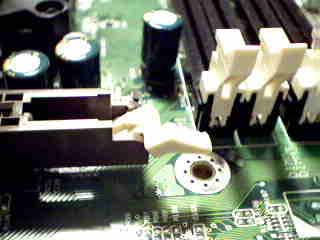EPoX EP-8KTA3 Socket-A KT133A ATX
by Mike Andrawes on January 25, 2001 4:48 PM EST- Posted in
- Motherboards
The Main Features
The new VIA 8363A North Bridge sits to the left of the CPU socket, also covered by a HSF unit. As we mentioned in the KT7A-RAID review, the VIA 8363A North Bridge is dissipating a considerable amount of heat, which might directly affect the stability of the system. Therefore, don’t be surprised to see more motherboard manufacturers start using HSF units on the 8363A North Bridge for optimal cooling.

The 8363A is the core of the KT133A chipset that provides all the major features of the board including the 133MHz FSB, 100 / 133MHz memory bus, as well as AGP 4X support. The AGP Slot is a universal slot, which means it is not keyed specifically for AGP 2X or AGP 4X cards, so you can install almost any current AGP card in the slot. At the end of the AGP slot, EPoX puts in a locking mechanism that helps hold the AGP card in place. It is a little clip that works similarly to that of a DIMM slot, by clipping into a small tab at the end of the AGP card.

In the past, the KT133 chipset had been disappointing in terms of FSB overclocking, where virtually no one can make any use of the FSB frequencies greater than 115MHz, in most cases. Now the 8363A North Bridge officially supports the 133MHz FSB (266MHz DDR), thus offering support for the new 133MHz FSB Athlons as well. In the past, even with 1GHz Athlons, users are limited to a FSB speed of 100MHz and a multiplier of 10. Now the KT133A chipset allows users to have FSB speeds of 133MHz and possibly higher, so that with the same 1GHz chip, users can lower the multiplier to 7.5, effectively boosting the overall performance while remaining at the same clock speed.
Most of the recent AMD Socket-A motherboards have included the hardware mechanism for changing the multiplier ratio settings of AMD processors, so this can be done easily. There is some effort required on the user’s part to prepare their CPUs for overclocking; however, we have diagrammed exactly what is necessary in our Athlon Overclocking Guide.
One special thing about the EP-8KTA3 is that it has a total of four DIMM slots. However, it can still support up to a maximum of 1.5GB SDRAM. The KT133A chipset, just like the KT133, supports a total of six memory banks, and a total of 1.5GB (thus 512MB per two banks). Therefore, DIMM3 and DIMM4 are actually sharing bank 5 and 6, so if you want to populate both DIMM slots, you have to use single sided SDRAM. If you use double-sided DIMMs, you can only populate one of the two DIMM slots.
Like the old VIA 8363 North Bridge that the 8363A is replacing, it allows users to run their memory at either 100MHz or 133MHz. When running 100MHz FSB, you are given the option to run your memory at 100MHz or 133MHz. At 133MHz FSB, the situation is changed slightly. The chipset will only allow you to run your memory synchronously with the FSB if you set the frequency to 133MHz or higher. Officially the KT133A chipset only supports FSB - Memory ratios of 100 - 100, 100 - 133, or 133 - 133.
The VIA 686A South Bridge has become history, and the newer VIA 686B South Bridge has replaced it. They both have a second USB controller hub and an integrated PCI to ISA bridge. The advantage of the 686B over 686A is that it supports Ultra ATA 100, whereas the 686A only supports Ultra ATA 66. The Ultra ATA 100 controller provides two IDE channels that support up to 4 IDE devices (two per channel).
Two traditional USB ports are mounted at the back of the motherboard together with the serial/parallel ports, and there are connectors ready for a third and fourth USB port at the back of the board. To make things easier, EPoX includes the USB header to take advantage of the second USB controller hub.
From the expansion slot perspective, the EP-8KTA3 is just as brilliant as the KT7A-RAID. The 6/1/0/1 (PCI/AGP/AMR/ISA) expansion slot design provides an almost perfect combination for all the hardware enthusiasts out there. No one has really made good use of the AMR slot, which is also supported by the 686B South Bridge. Instead, EPoX decided to take advantage of the PCI-ISA bridge of the 686B South Bridge, and provided an extra ISA slot for users with an old ISA modem or SCSI controller card.
For onboard audio, EPoX uses the VIA VT1611A AC’97 audio CODEC. Once again,
it is capable of providing basic sound for normal users, but in order to get
premium sound effects, you should go for some external PCI sound devices.










0 Comments
View All Comments